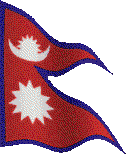Indrajatra started on from 24th of September and ended on 30th of September. With the installment of the Yashi, the Indrajatra started in Kathmandu Valley. The main action of the Indrajatra is the chariot procession of three Gods, Ganesh, Velu, and Goddess Kumari. The main attraction and importance is given to the Goddess Kumari in this festival.
On the first day, the chariots are being pulled by hundreds of people through the places namely, Basantapur, Maru, Jaisideval, Lagan, back to Jaisideval and Bhimsensthan, and back to Maru and finally rested at Basantapur where it started.
The second day, the chariots have its journey from Basantapur, Pyafal, Naradevi, Tengal, Bangemuda, Bhedasingh, Indrachowk, Hanuman Dhoka, and back to Basantapur.
After the second day there is no chariot journey for three days. On the fourth day, the final third journey begins from Basantapur, Pyafal, Naradevi, then Kilagal, Bhedasingh, Indrachowk, Hanuman Dhoka, and then finally to Basantapur.
The first and the last day, our King (ruler of the Nepal) used to visit and have the tika from Kumari. But since the republic democracy has been established in Nepal, the Prime Minister attended the ceremony in the place of the king this year. I don’t know if this is the right thing to do as there is a history where in the recent past whith dates back at least two centuries to the last Malla King of Kathmandu, Jayaprakash Malla. He once had intercourse with a pre-pubescent girl and as a result the young girl later died. The king was then told in his dreams to start the institution of the Kumari, worship her and once each year convey her around Kathmandu as penance for his sins. The institution may have existed even earlier and only the custom of the Kumari visiting the city by chariot started at this time. The last Malla king of Kathmandu was defeated on the day of the Kurari festival (Indrajatra) and the first king of the present Shah dynasty received his blessing on that same day as was customary which has now been broken as this year the Prime Minister received the blessings instead of the king.
Anyway, the Indrajatra finally ended after the procession of the chariot was completed, and the installed Yashi was put down and dragged to the Bagmati River.



 Kumari means basically virgin pre-pubescent girl in English. The Kumari of Kumari festival of Kathmandu is not born a goddess nor does she remain one all her life. She is always chosen from a caste of Newar goldsmiths (Bajracharya and Shakyas) and is usually about five years old, it is essential that she has never been hurt of shed blood. After careful screening by a number of people including the astrologer, the selected candidates, about 10 in number, are locked in a dark room where fearful-looking masks and freshly slaughtered buffalo heads are kept. Frightening noises are made from outside and the girl who shows least fear is selected. She is installed on her throne, in the same room where she lives, during the Dashain festival and the spirit of the goddess is said to enter her body after this ceremony. As soon as she reaches puberty, the Kumari becomes human once more and a new goddess must be chosen.
Kumari means basically virgin pre-pubescent girl in English. The Kumari of Kumari festival of Kathmandu is not born a goddess nor does she remain one all her life. She is always chosen from a caste of Newar goldsmiths (Bajracharya and Shakyas) and is usually about five years old, it is essential that she has never been hurt of shed blood. After careful screening by a number of people including the astrologer, the selected candidates, about 10 in number, are locked in a dark room where fearful-looking masks and freshly slaughtered buffalo heads are kept. Frightening noises are made from outside and the girl who shows least fear is selected. She is installed on her throne, in the same room where she lives, during the Dashain festival and the spirit of the goddess is said to enter her body after this ceremony. As soon as she reaches puberty, the Kumari becomes human once more and a new goddess must be chosen.









 It was Gai Jatra, one of the other interesting festival, on August 29 2007. This festival is celebrated in the memories of the lost family member during the last year. The word Gai Jatra came from two words Gai (which means Cow) and Jatra (
It was Gai Jatra, one of the other interesting festival, on August 29 2007. This festival is celebrated in the memories of the lost family member during the last year. The word Gai Jatra came from two words Gai (which means Cow) and Jatra (







